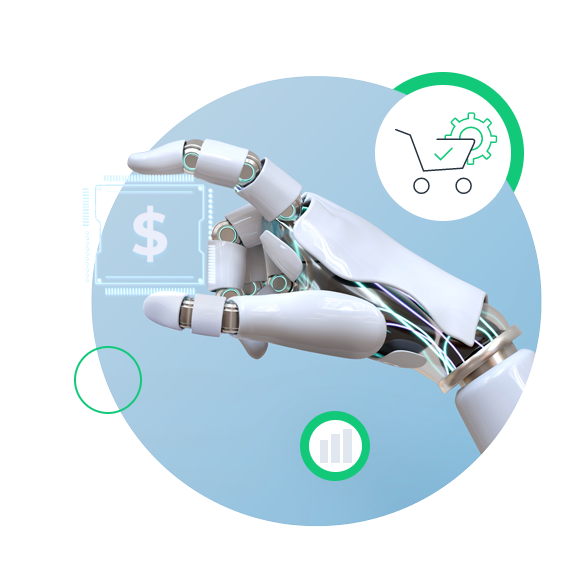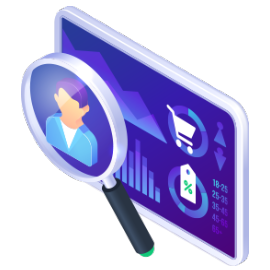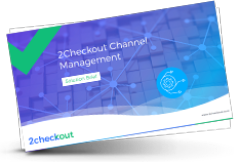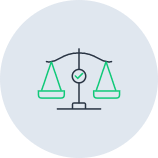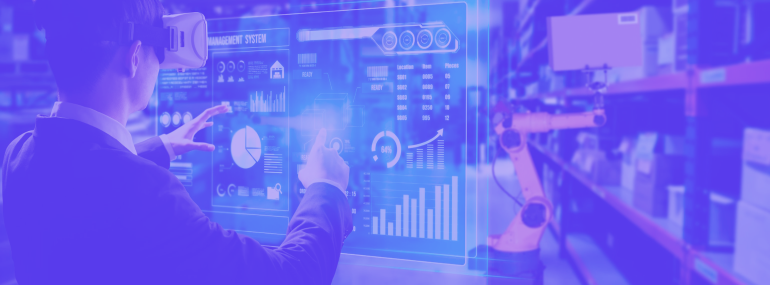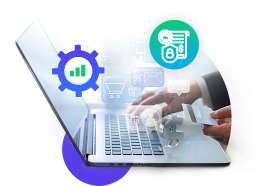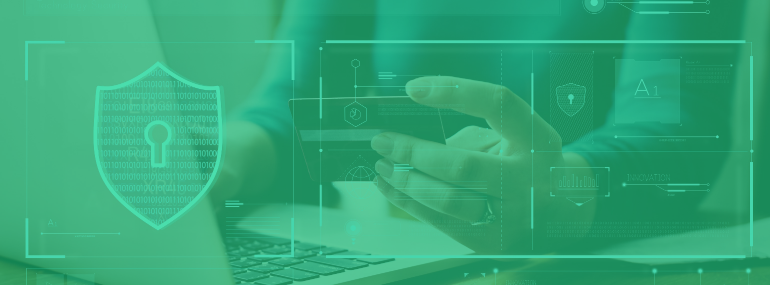Intro
As we navigate the aftermath of global disruptions like the COVID-19 pandemic, businesses are more eager than ever to streamline operations and reduce cost, highlighting the growing significance of B2B eCommerce in the economy.
For instance, by 2030, the global market for AI in business processes is projected to reach $2,025 billion, up from $515 billion in 2023 - a staggering 293% increase in just seven years. It is crucial to acknowledge that this is not a fleeting fad, but rather a substantial and lasting change.
It's time to trade in your current business playbook for a new game plan.
This guide will show you how to embrace the fast-paced, ever-changing world of B2B eCommerce to scale your business, and help you navigate the major challenges in this market, offering the tools to expand your business globally.
What Is B2B eCommerce, Trends and Statistics
Think of B2B eCommerce as a bustling global marketplace, open 24/7 and just a click away.
B2B digital commerce is defined as:

The buying and selling of goods and services between two companies, using the
Internet, mobile networks, and commerce infrastructure.
Two factors primarily set it apart from its consumer-focused, or B2C, counterpart:

REPER
Market Size and Growth
The B2B digital commerce market is six times larger than the B2C market. Moreover, it's expected to grow at a Compound Annual Growth Rate (CAGR) of
17.5%from 2020 to 2027. Asia leads in terms of gross merchandise volume in B2B eCommerce sales. China saw a
fourfold increasein the value of B2B eCommerce transactions, followed by North America.

REPER
Scale and Opportunity
The global B2B digital commerce market offers greater opportunities for business growth and international expansion. The COVID-19 pandemic has accelerated this trend, as restrictions have pushed more businesses to adopt online sales channels, thereby enhancing the purchasing experience on eCommerce platforms.
In the past, B2B transactions typically involved only a limited number of participants, such as the seller, distributor, procurement specialists, and business leaders.
Now, the landscape has shifted.
The way businesses buy things has changed because of software-as-a-service platforms and technology. More people in a company can now be involved in making decisions about what to buy.
So, why is this shift significant?
Today, B2B customers expect
personalized experiencesthroughout the buying journey, including tailored solutions, custom pricing, and personalized recommendations.
Businesses looking to future-proof are already implementing advanced technologies such as AI, machine learning, and blockchain into their current
B2B business operations. This helps to streamline automation, enhance security, and empower data-driven decision-making.
To meet the expectations of ethical B2B buyers, companies need to prioritize sustainability and social responsibility. This means using sustainable materials and having a robust
sustainability strategy.
All this to say, if you're not planning ahead, you're falling behind.
CommerceNOW '23 | WEBINAR
How is B2B alike but also different to B2C
For both emerging and established brands, understanding the dynamics of B2B commerce is crucial. While B2B and B2C markets were once considered entirely different, modern insights reveal striking similarities between the two.
Let's delve into the shared and unique traits of these markets:
REPER
01. Decision-Making:
Both B2B and B2C buyers consider objective factors such as cost, reliability and contractual terms when making purchasing decisions.
REPER
02. Emotional Factors:
Despite what may be commonly believed, B2B buyers are influenced by emotional and subjective factors when making purchasing decisions, similar to B2C buyers. Questions such as "Can I trust this brand?", and "Does this brand align with my values?" play a significant role in their decision-making process.
To add to that, B2B buyers are 50% more likelyto purchase products that they believe they will personally gain from.
REPER
03. Informed Choices:
Across both markets, consumers and businesses alike prefer to conduct thorough research, often relying on third-party recommendations to validate their purchase.
REPER
04. Customer-Centricity:
A robust customer service framework and a user-first approach are universally beneficial, driving success in both B2B and B2C markets.
Recognizing how your B2B buyers think and feel when making their purchasing decisions is not just beneficial, but rather absolutely necessary for succeeding in the B2B eCommerce ecosystem.
The Importance of Understanding Your Audience
REPER
The more intimately you understand who your customer is, the better you can build an effective buyer's journeyaround that persona.
The buyer's journey is the process consumers go through to become aware of, evaluate, and purchase a new product or service. Understanding this journey is critical to building effective sales and marketing strategies across all channels.
To better understand your customers, start with the following:
Define your audience target segments based on their traits. Focus on job roles, market segments, and behavioral factors.
Tailor your marketing and sales strategies to meet your customer base's specific needs and preferences. Map and create content across all your channels directed to each of your audience segments.
When it comes to B2B, remember that you are dealing with various roles within a single organization-technical teams, operations, customer service, and others. Tailor your approach accordingly.
- Make Data-Driven Decisions:
When in doubt, find available data to fuel targeting, delivery, messaging, and optimization across all your customer segments.
REPER
What role do they hold at their company, what industry is it in,
and who does it serve?
REPER
How many people work
for their company?
REPER
What are the skills, knowledge set, and tools necessary for their role?
REPER
What education did they get
to prepare for their work?
REPER
Additionally, the following questions can help you paint a clear picture of your ideal client:
REPER
What does a typical day
look like in their role?
REPER
How do they define success
in their job?
REPER
What are the top five challenges
they face in their job?
REPER
What are their short and
long-term goals?
It is crucial to acknowledge that while B2B and B2C eCommerce share some similarities, there are unique challenges that exist in the B2B landscape. These challenges can arise from the complexities of the product being offered or the ordering process.
As a result, B2B operations typically require a higher degree of customization and specialization to effectively manage these complexities. As we delve deeper into B2B digital commerce, our next focus will be on the various types of B2B eCommerce models.
Knowing which model best suits your business can be the difference between a thriving company and a struggling one.
Types of B2B eCommerce
The future of B2B sales is increasingly digital. By 2025, a staggering 80% of B2B transactionswill occur online. Yet the digitization doesn't end there, as new digital technologies are enabling businesses in both B2C and B2B sectors to expand into each other's markets.
This suggests that the lines between B2B and B2C are blurring, and businesses should be prepared to operate in a more fluid, multi-channel environment. Failure to adapt to these changes could result in lost opportunities and a diminishing market share.
To better prepare for this evolving landscape, it's crucial to understand where your business fits in the broader ecosystem. The following are key types of B2B digital commerce models that your business can fall into:
B2B2C (Business-to-Business-to-Consumer): This model eliminates the middleman, connecting businesses directly with consumers. An example is a manufacturer partnering with a B2B entity or selling directly to the end consumer online.
Wholesale: Businesses buy goods in bulk directly from manufacturers or distributors and sell them for profit. With digital platforms, this process becomes seamless, efficient, and scalable.
Manufacturers: These businesses produce goods, often selling them to other manufacturers, suppliers, or wholesalers. The automotive industry is a prime example, where individual parts are manufactured and sold to car assemblers.
Distributors: This model relies on working closely with manufacturers to bring visibility to their products and move them along the distribution channel. Online shopping websites have made this process much faster and easier, giving businesses a chance to grow like never before.
B2B2B (Business-to-Business-to-Business): Adds extra layers to the traditional B2B model, involving multiple businesses in the chain, like sub-distributors and wholesalers.
D2C (Direct-to-Customer): Allows B2B brands to sell directly to the end consumer, increasing market share and brand loyalty.
B2M (Business-to-Many): Allows businesses to sell through multiple channels simultaneously, broadening their customer reach based on target audiences.
B2E (Business-to-Employee): Focuses on internal procurement, such as a company selling specialized tools to its employees.
B2G (Business-to-Government): Sells to government agencies, similar to a manufacturer of protective gear selling to law enforcement.
REPER
Understanding the type of a B2B model that aligns with your business is crucial as:
- Different models are designed to cater to various market segments - from local to global.
- Some models are better suited to handle complex products that require customization, while others may not be as effective.
- The sales cycle's length and degree of complexity can vary significantly between models.
It's important to be aware of the potential issues that can harm your digital strategy, especially once you have a good grasp of the different B2B models.
B2B eCommerce Mistakes to Avoid

Navigating the B2B eCommerce landscape can be challenging.
Here are six common mistakesbusinesses should avoid: Missing the Mark on Target Audience
Don't just extend your offline business model to the online world. Treat your eCommerce platform as a new venture. Understand your audience's needs, wants, and pain points.
The B2B sales cycle is often complex and involves multiple decision-makers. So, get to know them all and tailor your sales approach individually.
Skimping on Content
Content is king, even in B2B. Don't just stick to eBooks or infographics. Your customers are looking for detailed product descriptions, how-to guides, webinars, and other engaging content assets.
The more informational value you provide, the better are your chances of standing out. Invest in thought-leadership content marketing.
Limited Payment Options
B2B buyers are old-school when it comes to payments. They still prefer checks, credit cards, wire transfers, or cash-on-demand.
Ensure you offer these traditional payment methodsto accommodate their preferences, while simultaneously adapting modern payment trends.
Picking the Wrong Tools
Choosing the wrong eCommerce platform can be a major setback for your B2B business. These operations typically require specialized features, like flexible billing options and strong security measures.
While using third-party apps to fill these gaps might seem like a good idea, it comes with risks. Relying on multiple apps or integrations can leave you vulnerable to system outages caused by a single update or code change.
To avoid these issues, it's best to choose a platform that aligns with your long-term goals and provides all the necessary features and capabilities to help you achieve them.
REPER
Neglecting Customer Experience
B2B buyers also expect a consumer-like experiencewhen doing business. Don't make your website all about your brand and your products. Focus on how you can solve their pain points.
Being aware of these pitfalls enables you to craft more effective digital strategies. Let's explore the steps to achieve this for your business.
No Self-Service Options
Today's B2B buyers are tech-savvy. When it comes to simpler B2B deals, most prefer doing their own research online rather than talking to a sales rep.
Offering a self-service option on your platform can hence go a long way. It's not just a nice-to-have;it's expected.
With that being said, it's still important to note that a self-service option doesn't eliminate the need for assisted sales.
When it comes to complicated B2B deals, buyers want someone who can offer them personalized advice and knowledge. It's important to find a good balance between letting them handle things on their own and assisting them through the sales process.
SOLUTION BRIEF
Want to learn more about what each model implies in terms of order and payment management, localization, compliance and more? Then make sure to get a free copy of this eBook!
Navigating the B2B Buying Journey:
What You Need to Know
Think about the last time you called a sales rep to learn about a SaaS product. It must have been a while because you've probably already found most of the information you need online.
This sheer amount of available information gives customers the power - in most cases, they no longer need a sales rep to get the lowdown on a business's products.
Gartner's researchshows that most B2B buyers complete over 70% of their research before even reaching out to sales, resulting in fewer chances for sellers to influence customer decisions. But that's not to say businesses have no influence.
A standard B2B buying journeyis complex, often involving 6-10 decision-makers with varying goals and opinions, making purchasing decisions increasingly difficult.
To make a successful purchase and regain control, B2B customers need to perform six important "jobs" according to a recent research. These tasks are crucial for the final purchase decision and require careful attention to detail.
As you read through these "jobs, " ask yourself where your business provides a definite answer and where it doesn't. This can help you establish a starting point and the stage of the buying process to focus on.
The B2B prospect thinks:
Problem identification
"Something needs to change."
Solution exploration
"What solutions are available?"
Requirements building
"What should our ideal solution accomplish?"
Supplier selection
"Will this meet our needs?"
Validation
"Looks good, but let's double-check."
Consensus creation
"Let's make sure we're all on the same page."
So, knowing this, it's crucial to engage with your customers at every step of their buyer's journey. Let's break down each stage:
REPER
The Awareness and Discovery Stage
Remember that the journey isn't linear for your buyer- they are often revisiting each of those six buying jobs at least once.
This is your chance to grab attention and spark interest when it matters most. Aim to be the brand they think of first when they realize they have a need.
REPER
The Consideration and Evaluation Stage
At this stage, buyers are doing their homework. They're comparing you to competitors and might even contact your sales team. Be prepared to answer their questions and offer demos or other personalized services.
Remember, 61% of B2B buyerstrust peer reviews and recommendations, so ensure you're on top of that.

REPER
The Decision Stage
By the time buyers reach the Decision Stage, they've done their homework. They've researched, compared, and are ready to make a purchase.
However, as mentioned before, B2B sales cycles are often more extended and complex than B2C, sometimes taking up to nine months to close.
Your primary objective here is to streamline the buying process, making it as effortless as possible for the buyer to say "yes."
To achieve this, you have two strategic options:
Option 1:
The Hybrid Sales Approach
In a hybrid sales approach, you combine the convenience of online self-service with the personalized touch of sales representatives.
With 77% of B2B buyerssaying the last purchase they made was complicated, your aim is to simplify the buying process.
This strategy is particularly useful for reaching buyers who lean towards digital platforms for initial research. However, for complicated questions or important decisions, people still appreciate some human interaction. The aim is to offer the best of both worlds: the speed and efficiency of online transactions with the trust and personalization that comes from one-on-one interactions.
Option 2:
The Self-Service Approach
For businesses, especially software companies aiming to modernize their sales process, a Self-Service Approachcan be a game-changer. This strategy involves setting up an advanced self-service channel that bridges your marketing and sales departments.
Opting for a Self-Service Approach provides the following benefits:
- Boosts customer satisfaction by allowing buyers to interact with products on their own terms.
- Turns your marketing efforts into a direct revenue stream, making every dollar count.
- Generates valuable usage data that can inform product design, pricing, and marketing strategies.
- Eliminates channel conflicts, fostering better collaboration between marketing, sales, and commerce departments.
- Introduces Usage-Qualified Leads (UQLs), providing your sales team with highly actionable insights based on actual product usage.
By choosing the right approach, you align your sales process with the customer's journey, making it easier for them to move from consideration to purchase.
REPER
The Loyalty Stage
The journey doesn't end with a purchase. Now's the time to keep your customers happy and turn them into advocates for your brand.
Handle this stage well;you'll retain customers and gain new ones through word-of-mouth and positive reviews.
Aligning your sales strategy with the customer's journey enhances their experience and boosts your revenue and brand reputation in the long run.
Creating a Seamless Synergy For Your Customers
As noted above, the future of B2B sales lies in successfully integrating self-service and personalized sales support. These two approaches should not operate in silos but should complement each other to offer a comprehensive, tailored customer experience.
This blended approach streamlines the sales process and ensures that leads move smoothly from the marketing funnel to sales conversion.
Solutions like 2Checkout (now Verifone) can be extremely helpful in this integration. They offer the digital infrastructure needed to support self-service and personalized sales efforts, helping you achieve higher sales, satisfied customers, and increased revenue.
By synergizing self-service and assisted sales, you're not just closing deals but building relationships and creating satisfied customers who will likely return and recommend your services to others.
Now that we've explored how to create a balanced sales approach let's turn our attention to optimizing your B2B eCommerce website for maximum impact and customer satisfaction.
What Is B2B eCommerce: Key Trends and Statistics
Your B2B eCommerce websiteis more than just a digital storefront;it's a decisive touchpoint in your customer's journey. While the fundamentals of a good website are similar across B2B and B2C, the B2B space has unique challenges and opportunities.
The following is a blueprint to follow when building out a successful B2B eCommerce site:

REPER
User Experience and Customer Focus
Concentrate on Customer-Centric Design: Your website should mirror customers' needs and aspirations. Use your developed customer personas to guide both the content and technical aspects of your site. For instance, if you're targeting small businesses, your language, imagery, and solutions should resonate with that audience.
Speak Their Language: Keep your language simple and precise. Translate your product capabilities into customer benefits. Instead of saying "scalable architecture, " say "a system that grows with your business." Word choice matters.
Easy Access to Sales Team: Offer a non-intrusive way for visitors to reach out for help. Think of it as a virtual "May I assist you?" that pops up at the right moment. Never fully eliminate the human element within your business.
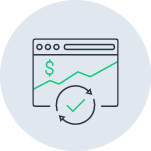
REPER
Sales and Conversion Optimization
Self-Service Capabilities: Move beyond the era of cold-calling. Enable customers to handle routine tasks within your site, similar to self-checkout kiosks in supermarkets. Use the hybrid or full-service approach discussed above.
Always Use Clear Calls-to-Action (CTAs): These signposts guide visitors through your site. Make them specific and goal-oriented, like "Download Your Free Guide" instead of a generic "Click Here." Every click counts.
Flexible Ordering Options: Cater to the unique purchasing patterns of B2B buyers. Features like bulk ordering, minimum order quantity, one-click reordering, and instant quote generation should be standard on your site. Convenience is key.
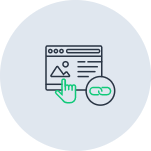
REPER
Content and Educational Resources
Educational Content: Offer resources that help customers make informed decisions. This could range from whitepapers to webinars. Good educational content not only adds value but also boosts your SEO. Remember, your site is a decisive moment in a customer's journey - strive to always provide more value.
Showcase Client Success Stories: Use case studies to demonstrate how your product helps to solve problems. Organize these stories by industry or make them easily searchable. This social proof will boost your credibility.

REPER
Lead Generation and Nurturing
Build Effective Landing Pages: These pages serve a dual purpose in your digital strategy. First, they act as a gateway to capture customers through the use of lead magnets, like a free eBook or a product demo. Second, the acquired data-- the visitor's contact information--can then be leveraged for further lead nurturing.
Streamlined Sign-Up Pages: The main goal of these pages is to encourage people to register for your solution. It's important to focus on a customer-centric design. This includes using a headline that highlights the benefits, and a compelling call-to-action. Try to shorten your forms. It's recommended to only include the required form fields to make it easier for visitors to convert. The fewer obstacles between a visitor and conversion, the better.
Transparent Pricing: Offer a separate pricing page that breaks down costs. Display pricing options in tiers that cater to different buyer personas. Additionally, consider the reading flow;most people read from left to right, so display prices based on a user's region.
By focusing on these areas, you're not just building a website but creating a comprehensive digital experience that guides your customers from awareness to conversion.
Now that we've laid the groundwork for an optimized B2B eCommerce site, it's time to discuss how to effectively get your message out there and attract the right audience. The channels you choose for marketing are just as crucial as the website you've fine-tuned.
LANDING PAGE
Want to better understand the obligations and opportunities that come when operating within today's dynamic tax landscape? Make sure to watch this webinar to find out how an MoR can outsource the complexity of taxation and help you scale quicker.
B2B Marketing Channels
As mentioned many times, knowing your audience is key - the "who" behind the "why".
This is especially true in B2B marketing. Unlike B2C buyers, who often make impulse purchases driven by emotion, B2B buyers are more calculated. They focus on return on investment (ROI) and usually make decisions collectively.
Remember, the B2B sales cycle is complicated. Your B2B customers are constantly looking for solutions to make their lives easier.
With the understanding that B2B buyers are a unique breed with specific needs and decision-making processes, let's explore the various channels that can effectively engage this audience and drive meaningful interactions:
REPER
The Website
Your website is always the first step. It's often the first point of contact between your business and potential B2B buyers;therefore, it must be optimized for conversions.
Apply the principles discussed earlier to ensure your website outlines your offerings based on your target industries.
Don't forget to prioritize responsiveness across all devices for a smooth user experience.
REPER
Marketing Automation
Marketing automation serves as a digital extension of your marketing team, providing a personalized touch to customer interactions. When used effectively, marketing automationincreases your ROI and boosts your conversion rates.
Think of it as an around-the-clock virtual sales assistant, engaging with customers based on their unique interactions with your business and steering them through their purchasing journey.
Implement automation strategies to effectively target customers at any stage in their buyer's journey. Remember to set clear objectives and measure progress - data-driven decision-making creates a thriving business.
REPER
Content Marketing
In B2B, content marketinggoes beyond brand awareness. It's about establishing your brand as a thought leader in the industry and creating an emotional connection with your audience in the process.
Consider these three pillars when building out your own strategy:
- 01. Why(the objectives and needs of the customer)
- 02. When(timing and relevance)
- 03. What(type of content)
The goal of content marketing is to educate and provide value to your B2B buyers rather than entirely focus on promoting your product.
Different types of content should also be developed to cater to customers at each stage of the buyer journey, like blogs, whitepapers, and webinars.
By using relevant, value-packed content, a B2B brand can establish itself as an authority in its industry, driving customer trust, conversions and growth.
REPER
Social Media Marketing
Lead generation through social media is more of an art rather than a science.
When building your social media marketing strategy, start with a clear goal (i.e., "I want to increase followers".) Next, identify the platforms where your target audience spends their time.
This is followed by creating exciting and valuable content that resonates with your audience. Finally, interact with followers to build good relationships and credibility.
Platforms like LinkedIn, Facebook, and Instagram are not just for B2C marketers. Given that 35% of millennialsand many older consumers are making purchases via social media, having an online presence is a must in 2023.
REPER
Events and Networking
Despite the digital age, nothing beats the power of face-to-face interactions.
Events and conferences offer unparalleled opportunities for relationship-building, which emails or calls just can't replicate. Your prospects are there with a business mindset, ready to engage.
REPER
SEO
Search Engine Optimization (SEO)remains a cornerstone in B2B marketing. High-quality, SEO-optimized content like blogs and landing pages can significantly boost your visibility in search results, attracting more qualified leads.
REPER
Influencer Marketing
Influencer marketing isn't just for B2C. Partnering with industry influencers can amplify your reach and lend credibility to your brand. Choose influencersbased on their engagement, content quality, and relevance to your industry.
Research has found that 86%of B2B brands see increased ROI with influencer marketing, so it's certainly a channel you need to experiment with.
REPER
Pay-Per-Click (PPC) Advertising
Though organic followers are valuable, achieving visible results can be time-consuming. Paid advertising offers quicker and more tangible results through audience segmentation and the ability to choose the right ad type.
Note: 61%of all U.S. web traffic originated from mobile devices in 2020. This means focusing on a mobile-first strategyis critical for long-term success.
Additionally, PPC can be a costly but effective strategy for immediate visibility. It's particularly useful when paired with your SEO efforts. Google Adsis the go-to platform for most B2B marketers due to its extensive reach.
REPER
Word-of-Mouth: Referral Programs
Never underestimate the power of a good referral. Implementing loyalty programscan significantly boost growth, sales, and customer retention for relatively little cost. These programs can also provide useful market research data.
However, only 16%of organizations believe their loyalty programs to be effective, so it is crucial to develop a successful strategy. A well-designed referral program, integrated into an effective marketing strategy, can be a goldmine for quality leads.
REPER
The Second Chance: Remarketing
Remarketingis your opportunity to re-engage with prospects who've interacted with your brand but haven't converted. It's a way to remind them why they were interested in the first place and nudge them towards a decision.
Test multiple versions of an ad to identify the most effective version before launching a more extensive campaign. Publish ads on platforms where your target audience spends most of their time. This will help you maximize reach and engagement.
Don't forget to analyze user behavior on your website, such as pages visited or forms filled, to send personalized retargeting ads or emails based on their activity.
Achieving success in B2B marketing involves identifying the most effective communication channels that align with your business objectives and resonate with your target audience.
This requires a strategic approach that considers your customer's journey and interactions with your brand, while the results can increase customer retention, loyalty, and revenue.
Payment Methods in B2B eCommerce
Payment processes in the traditional B2B landscape can be slow and tiresome. While methods like paper checks, open invoices, and trade credits have their place, they often result in delays and administrative headaches.
However, the digital revolution is now transforming the industry and providing a variety of faster, more efficient, and secure options. This means businesses can save significant amounts of time and money by adopting digital payment methods.
Understanding the nuances of various payment methods is not just a nice-to-have;it's a must-have for any business looking to thrive in today's fast-paced digital environment.
Before diving into the digital alternatives, let's take a quick look at some of the traditional B2B payment options:
Instant Credit:
Granted to customers after a thorough financial evaluation.
Trade Credit:
Exchanging goods or services without having to pay for them right away.
Cash on Delivery (COD):
Payment is made in cash upon the delivery of goods.
Paper Checks:
Mailed to the merchant and subject to clearing times.
Traditional Payment Methods in B2B eCommerce
Wire Transfers:
Money moved from one bank to another, often facilitated by a third party.
ACH Transfers:
Direct transfers between bank accounts, which is gaining popularity over checks.
Purchase Orders and Invoices:
A more formal process that involves order placement, invoice delivery, and payment.
Credit cards:
Increasingly used for both personal and company expenses.

REPER
The Digital Advantage: More Than Just Speed
While the B2B sector has often prioritized payment speed, the benefits of digital payments extend far beyond quick transactions.
Understanding the popular online payment methods, both globally and regionally, can help you enhance your customer experience and increase sales.
Credit and debit cards remain dominant, with debit cards leading the market at 94 transactions per personglobally.
E-wallets, like PayPal, AliPay, and ApplePay, are also gaining popularity, primarily in Asia-Pacific, but also in North America and Europe.
Other emerging payment methods include:
- Buy Now Pay Later (BNPL) services
- Prepaid cards
- Electronic checks (e-checks)
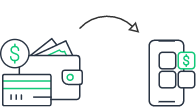
REPER
Making the Transition to Digital Payments
The shift to digital is already underway, thanks to initiatives from various banks, fintech firms, and industry specialists. Organizations like The Federal Reserve and NACHA are working to offer faster electronic payment options, including same-day or real-time transactions.
For businesses looking to make this transition, it's vital to offer a balanced mix of payment methods that cater to B2B customer preferences while streamlining internal operations.
The complexities involved in this shift can be easily managed through technology, making adopting flexible digital payment options feasible and highly beneficial.
By embracing digital payments, B2B eCommerce merchants can speed up transactions and introduce efficiency and flexibility that can be a game-changer in the long run.
CommerceNOW '23 | WEBINAR
Innovate Your Shopping Experience With A/B Testing & Analytics: Driving more sales should not be a promise, but a guarantee. In this session, our very own Senior CRO Specialist Nicoleta Danilet will explain how you can innovate the shopping experience for your audience through A/B testing.
Want to learn more? Find out:
Wrapping Up
REPER
In the fast-paced world of digital commerce, B2B businesses must adapt or risk falling behind - especially in a market that's six times larger (and growing!) than its B2C counterpart.
Remember, to truly get ahead of your competition, the goal is to offer an unparalleled customer experience that not only meets but anticipates your B2B customers' ever-changing needs.
Need some additional help along the way? 2Checkout (now Verifone) is a leading eCommerce platform that provides practical solutions tailored for your eCommerce business success.
If you need powerful tools and support to help you optimize your online sales, sign up for freetoday. 2Checkout's full monetization capabilities could provide the extra boost you need.
 2Sell Accept mobile and online payments from buyers worldwide
2Sell Accept mobile and online payments from buyers worldwide
 2Subscribe Subscription management solution to maximize recurring revenue
2Subscribe Subscription management solution to maximize recurring revenue
 2Monetize Full commerce solution built for digital goods sales
2Monetize Full commerce solution built for digital goods sales
 Add-ons Additional services to boost online sales
Add-ons Additional services to boost online sales
 Login
Login
 Login
Login
